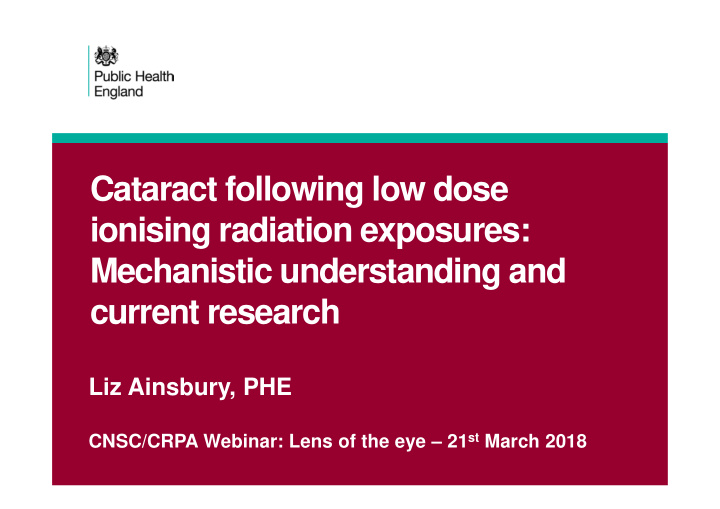



Cataract following low dose ionising radiation exposures: Mechanistic understanding and current research Liz Ainsbury, PHE CNSC/CRPA Webinar: Lens of the eye – 21 st March 2018
Human Lens Diameter ~9-10 mm, thickness ~4.5 mm Germinative zone of LEC Growth factors -> differentiation -> lens fibres Tight temporal and spatial organisation Deregulation -> cataracts
Radiation cataracts Cataracts are most frequent cause of blindness worldwide Multifactorial aetiology: Age related effect; Genetic component (congenital cataracts); Also: Sunlight, alcohol intake, nicotine consumption, diabetes, persistent use of corticosteroids, and ionising radiation … www.ndrs.scot.nhs.uk/Train/Handbook/drh-27.htm www.uveitis.org/patient/glossary/a_f.html
Radiation induced cataracts Ionizing radiation is generally (but not exclusively) associated with posterior sub-capsular opacities Adapted from Beebe , 2008 Well established paradigm: Radiation cataract is a deterministic, late, effect ICRP, 1990 (and 2007), and others: Thresholds for radiation induced cataracts: 2 Gy acute; 4 Gy or higher fractionated/ chronic exposures ’ ICRP 2011: Threshold ~ 0.5 Gy…
How does ionising radiation cause cataracts? Target cells: Germinative Zone on lens epithelium (?) Potential mechanisms might include: - Oxidative stress - DNA Damage/Repair/Mis-repair - Intracellular signalling - Gene expression - Cellular proliferation / mobility / migration - Damage to proteins/ECM/lipids - Post translational modifications - Senescence - Systemic/Non-targeted effects … Modifying factors: Dose, Dose rate, Age at exposure, Genetic background …
What do we know about oxidation? ROS: Degradation, cross-linking, aggregation of lens proteins, DNA damage Hamada e t al., 2014 -> Aberrant lens epithelial cell division, cell migration, differentiation…
Evidence from a study looking at DNA damage and repair Markiewicz et al., 2015: - Low dose, dose-response for DNA damage response in the lens - Lens (peripheral region) is more sensitive than circulating lymphocytes
Signalling: Tumour related factors Hamada and Fujimichi, 2015
Data on stimulation of proliferation Fujimichi and Hamada, 2015: “IR not only inactivates clonogenic potential but also stimulates proliferation of surviving unactivated clonogenic HLE cells” IR -> abnormal activity Historical data: Irradiation induces excessive proliferation of rabbit lens epithelial cells; suppression of lens epithelial cell divisions inhibits radiation cataractogenesis in frogs and rats Markiewicz et al. 2014:
Some publications on lens protein modifications Abnormal lens protein accumulation -> Aggregation, lens scatters light instead of focusing on the retina Bloemendal et al , 2004: Lens crystallins: α -, β - and γ -, form the refractive medium of the lens; proteins e.g. α A- or α B- protect from aggregation Muranov et al ., 2010: Protein changes in irradiated lenses similar to those seen in old age Wiley et al ., 2011: Role of abnormal cellular proliferation, e.g. p53 effect? Fujii et al ., 2001: Role of post translational modifications? May reduce solubility to alter transparency
Some genetics data Mouse models: ATM, RAD9, BRAC1 genes control signalling for DNA damage response signalling; Heterozygosity of these genes known to leads to increased risk of cancers Worgul et al., 2002: - Cataracts earliest in homozygotes for Atm, then heterozygotes, then wildtype - Severity and latency proportional to number of damaged cells attempting differentiation - Atm homozygotes/heterozygotes – genetic predisposition to cataracts Kleiman et al ., 2007: Cataracts develop earlier and in greater numbers in Atm/Rad9 double heterozygotes Smilenov et al., 2008: Atm/Rad9/Brca1 double heterozygotes showed increased resistance to apoptosis and increased radiation sensitivity Humans: e.g. Cataractogenic mutations in human crystallin genes
(Very basic) summary of current (incomplete) mechanistic hypothesis Systemic effects Post translational Ionising effects Radiation + + ++ Abnormal + differentiation and migration Radiation + Antioxidant cataract + capacity overwhelmed + + Dividing cells ROS + Abnormal Genetic + + + Protein / + accumulation + effects lipid / ECM of lens proteins damage
What do we know? Understanding of lens biology (structure, physiology, process of fibre cell formation) Radiation causes posterior subcapsular cataracts High dose responses; impact of RBE, LET, DR Number of potential competing/parallel mechanisms from wider cataract studies Cellular and tissue level studies ex vivo or in vitro support the paradigm of genomic damage of lens epithelial cells as key mechanisms of cataractogenesis Genetic background (e.g. heterozygosity for Atm or Ptch1 ), gene expression Age dependence, impact of normal aging Cataract detection/assessment
What don’t we know?
LDLensRad Project EJP CONCERT LDLensRad: Towards a full mechanistic understanding of low dose radiation induced cataracts Objective: “ To advance knowledge to solve the question of how radiation causes and/or promotes cataracts. This will be achieved by providing concrete evidence of the ability of radiation exposure <= 500 mGy to cause cataracts, the impact of dose protraction on the dose response and the biological mechanisms behind cataractogenesis .”
Specific research questions • Is there a low dose dose-response in radiation cataractogenesis? • What is the impact of dose rate? • What is the impact of genetic background? • What is the impact/involvement with the ‘normal’ aging process? • How are oxidative stress and intracellular communication, DNA damage, translational, proteomic and lipidomic responses, proliferation and lens morphology impacted by radiation? • Can the lens be viewed as an indicator of global radiosensitivity? • Are radiation cataracts most appropriately viewed as a deterministic/tissue reaction or a stochastic effect? LDLensRad will contribute to answering some of these questions but: Further collaborative research is needed!
Project collaborators and Advisory Board members , Roisin McCARRON 1 , Gabriele BABINI 12 12 :Università degli studi di Pavia, Via Bassi, 6 - 27100 Pavia - Italy
Acknowledgements EU FP7 DoReMi and Horizon 2020 CONCERT projects. The LDLensRad project has received funding from the Euratom research and training programme 2014- 2018 in the framework of the CONCERT [grant agreement No 662287]. UK Department of Health, Public Health England UK Health and Safety Executive National Institutes for Health Research Society for Radiation Protection NCRP SC1-23 Colleagues Unless otherwise stated, all figures taken from:
Thank you for listening! Questions/Comments/Suggestions? Liz.Ainsbury@phe.gov.uk
Recommend
More recommend